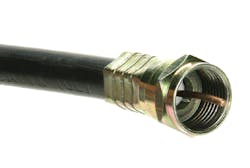Recently, HDcctv via coax cable — the use of coax to transmit an HD video using special cameras and recorders/controllers — has been the buzz of the video surveillance transmission industry. Initially, the idea seemed far-fetched but the fact is, nearly 80 percent of analog cameras were installed with coax cabling and most of those cable runs are less than 750 ft.
Consultants and specifiers, integrators and end-users alike need economical options for IP video applications, and the HDcctv manufacturers have stepped up to the challenge, creating Ethernet over Coax (EoC), a way to install IP and megapixel cameras on existing legacy coax — even supplying PoE if needed.
The advantage of an EoC solution is in its simplicity of design and application. Installation is easy, data is robust and reliable, and everyone saves money. The technology will enable more installers to approach an IP migration project with another set of financial and installation options.
Here are the top reasons to deploy an EoC solution for video surveillance:
1. Migration on Your Own Terms
EoC enables the end-user to choose when they would like to install IP equipment, because the migration can be done incrementally. If one was to install an entirely new UTP network infrastructure, the project would be done in one pass; on the other hand, legacy coax can be migrated from analog cameras to IP/Megapixel cameras in the timeframe chosen by the end-user.
2. Cost Savings
End-users, and thus the C-level, are always concerned about cost. EoC technology takes advantage of the re-use of legacy coax cable, and reduced labor, which can be as much as 25 percent of the cost of an IP upgrade.
There is another cost that is often overlooked — in some regions, leaving unused cable in place that is not connected at both ends, or not properly tagged for future use, is illegal because of fire and smoke fuel load safety. The U.S. National Electrical Code rules 800.2 and 770.2 prohibit the abandonment of unused cable. There is also the issue of removing cable while creating an asbestos contamination situation.
Removal and disposal/recycling of existing cable is expensive, sometimes impossibly so; in fact, in some cases, it is more expensive to pull out old cable than it is to install new.
3. No Network Disruption
Disturbing a facility’s operations can also be a major consideration. In the case of a factory, bank or a casino, uptime means money. Leaving coax in place means incremental camera swaps without interruption to normal operations. Think health care facilities, gaming operations, schools, etc.
Another advantage of EoC technology is that for the most part, it is a dedicated security network. That is, the use of legacy coax network keeps the video surveillance data off the so-called corporate data network.
4. No Repeaters or Extenders Necessary
With Ethernet and PoE, repeaters must be installed every 328 ft. For the installer, that typically means sourcing power in odd locations throughout the facility, in order to create a proper repeater data/power supply point. This is usually a lockable closet that has no power mains installed; thus, there is the added cost of installing a power plug/mains.
A camera at 750 ft. requires two repeaters. These repeaters, their associated connections, and the typical need for uninterruptible power supply (UPS) power, all add up to be a potential remote point-of-failure headache.
With the EoC-based PoE, 48V power is provided at the control room, and is distributed to the EoC transceivers and the IP cameras. There are no repeaters and the problem is solved without impacting the budget. Many IP cameras can get power from the existing 24VAC distribution system; however, PoE adds value, increases customer options and can simplify the design. With EoC-based PoE, cameras can operate from the same UPS as the control room equipment.
5. Plug-and-Play is Easy
EoC provides a plug-and-play transparent network that is easy to use, reliable and grants seamless integration between existing coax cable and the Ethernet backbone. EoC supports network protocols such as UDP, TCP/IP, HTTP, etc. with minimal configuration or setup needed.
6. Increased Efficiency
The typical EoC product on the market is point-to-point, meaning there is one locally powered transceiver at the camera and one locally powered transceiver at the control room. This is acceptable for small systems, but is not efficient for systems featuring large numbers of IP and megapixel cameras.
A better and more unique solution is to have a single EoC transceiver at the control room, which supports up to four remote transceivers and their cameras. This technology can leverage one coax run which splits out to supply transmission links to up to four cameras. Streaming video and PoE power are supported at distances far beyond the 328 ft Ethernet standard. This provides greatly enhanced legacy coax network system leverage, allowing for easy and cost-effective IP camera upgrades, with minimal install labor.
Guy Apple is Vice President of Marketing and Sales for NVT (www.securityinfowatch.com/10214493).



